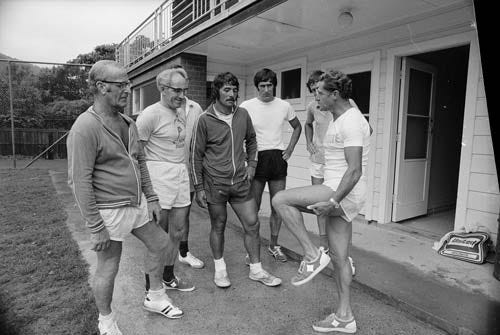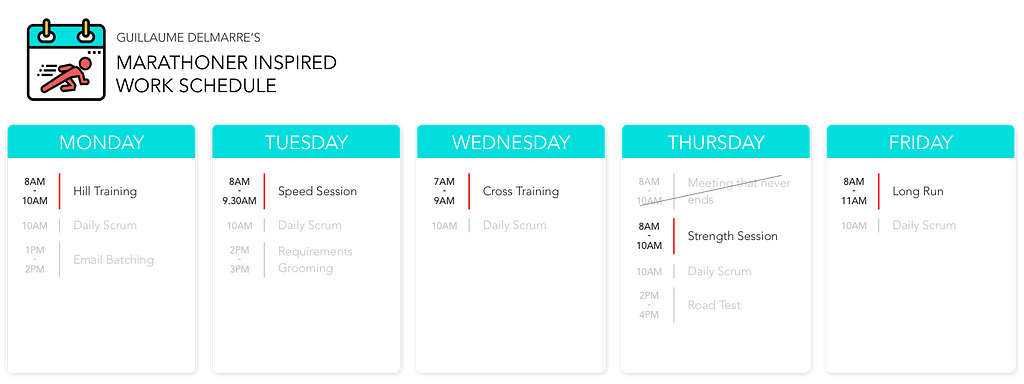Latest news about Bitcoin and all cryptocurrencies. Your daily crypto news habit.

As a product manager, my weeks are filled with many different objectives, deadlines, and firefighting. In the middle of all this noise, one habit that I found out to constantly increase my productivity is to block a few hours in my calendar, dedicated to the 4 following sessions: long run, speed session, cross training and hill training.
No matter if you’re trying to get more done every month at work, or if you want to achieve more on a personal level, this should be suitable for many different purposes. As you read about the different session, try to think about how you could adapt them for your own unique situation and goals.
But before you start reading, the key point is: if you are looking for a quick win, something to get out of all of your firefighting at work or other emergencies in the blink of an eye, you should stop reading it now. Just as runners training for a marathon, the benefits will not be seen before being consistent for a few weeks. But holy moly, when you start ripping the benefits! you’ll never come back.
What I really like about this schedule today is that, as opposed to a lot of self-help advices, this is something I was able to realistically implement in my life, without moving heaven and earth. Time constraints are not too restrictive, I can experiment different methodologies, iterate on them, and figure out what shows the best results for some specific outcomes, or what I should just give up. I may outgrow this workflow tomorrow, but not as long as it will show results or that I find something better.
1. Long runs
Most runners are familiar with the long, steady runs. These runs generally last for 2 hours, with an increase in mileage every week, to eventually average between 15 and 20 miles per run.
The goal here is threefold:
- teach the body to handle lowered blood glucose levels, as well as optimizing the body to be more economical,
- push the limits of the body and mind to keep on running,
- while testing one’s running gear and nutritional plan (both before, during and after the race).
During these long runs, runners pay a particular attention to listening to their bodies, finding a comfortable pace and focus on performing the best form: head tilt, shoulders, arms, torso, hips, stride, ankles and feet all play an essential role in the perfect running form.
How to do long runs at work?
I really like long runs for their many benefits, and I figured out a way to schedule a similar session in my weekly work schedule. It’s easy, common sense, but in every workday race, most people don’t give it enough time and attention. Somehow this approach is similar to Cal Newport’s Deep Work (in a more modest, easier-to-implement way).
The key points are as follow:
- Get away from social media, Slack, WeChat, quit your email app, put your phone on airplane mode. Get yourself a healthy snack and some water, so that you can recharge your energy along the way and have no excuse to leave your desk. You can start a playlist (but don’t start to skip songs or select a specific track! Listen to something helping you to focus, preferably with no lyrics). Just focus on what you want to achieve.
- Schedule a strict amount of time to focus. Let’s say 2 hours. And give yourself a goal for the session.
- The goal should be focused on deep work, not shallow work. The rule of thumb from Newport to identify shallow work is to ask yourself this one question: “How many months would it take to train a smart graduate student with no experience in my domain to do this task?” If the answer is merely a few days or weeks, even if the task is important, it is not considered as deep work.
The long run forces you to concentrate for an extended period of time. It should develop your core capabilities and help you focus on the details, the substance. The goal is not to cross all your bucket list item, but move on the most important one.
I like to use long runs to really level up the product requirements of the most important features I am working on, which usually come with a wealth of details to think through. One session would usually look like:
- warming up by trying to remember for a few minutes what is the status of what I need to do, and then continue the warm up by taking a look at my notes, open questions and action items
- then, get to work without pressuring myself to get too much done, but do things right.
- before the session ends, make sure that I documented the questions that came up during the session and what is my current status.
Some of the questions will get answers later during the day, on the way back home, under the shower… This session is really about steadily improving what I’m working on, and identifying clearly what will need to be figured out or refined afterward.
2. Speed sessions
Speed sessions help runners to gradually increase their speed for long runs and be more efficient using their energy. Runners can then sustain a more important effort for a longer period of time. But what is the logic behind it?
- Running fast makes you breathe harder, so does running long distances.
- VO2 max is the peak volume of oxygen you can consume and use in a minute. And while running at VO2 max (breathing as hard as you can) is rather painful, this is also extremely beneficial, as high VO2 max is closely-related with long distance running performance.
- The quickest way to get to your VO2max is through 6 minutes of sustained effort at your fastest pace. It is not the smartest way to go though as you’ll more likely be totally exhausted in the end. Runners should rather split the session in several shorter efforts at a slightly higher intensity with some rest in between.
Pomodoro as a speed session
Speed sessions at work can help you to: 1. develop quick thinking, and 2. deliver as much as you can every minute (you can call it “Productivitymax”, if you will).
Among the different productivity methods I’ve tried is the Pomodoro Technique. Even though it was bringing a lot of result, I could simply not do it every day.
The original Pomodoro Technique steps are really simple:
- Decide on a task
- Set a timer (usually 25 minutes)
- Work on the task
- After the time is up, take a short break (5 minutes)
- Repeat four times
The Pomodoro itself does not focus on speed or quality of execution, it is mostly about letting you focus on something for an amount of time optimized for concentration.
My twist on the Pomodoro, is that, as opposed to the long runs, I like to do things fast, not focusing too much on all the details. I often use it when I need to lay out the foundation of new features or work on some product presentation for my customers.
This is based on one single law:
- Parkinson’s law: “work expands so as to fill the time available for its completion”. Or, as Isaac Asimov puts it:
“In ten hours a day you have time to fall twice as far behind your commitments as in five hours a day.”
(So, get it done, fast.)
The goal is to get a first draft done, without spending too much time. It will help to see the structure of what you’re doing. I wrote more about the importance of the structure here.
3. Cross training and general strength sessions
Cross training (eg. swimming, biking, rowing, boxing…) and general strength sessions are aimed at developing abilities that are not specific to the running motion, or do not contribute directly to running (aka: moving you forward). These sessions help you become a more balanced, stronger athlete, eventually allowing you to handle a greater workload.
Running is a really repetitive motion, and the muscles used, or not used, for that matter, are always the same. As a consequence, there is an increased risk of injury for non-running activities, as well as running-related injuries.
Aerobic fitness (commonly referred to as “cardio”, the ability for the body to transport and utilize oxygen) will develop faster than your muscles. So while runners may feel good and be able to keep a conversation during 10 miles runs (referring to the fact that people should run at a “conversational pace”), a common injury is the shin splint. It is actually, according to this Danish research, the most common injury for new runners, totaling 15% of the running injuries. Shin split might limit runners for the next few days, as they’d need to get some rest to recover.
Including a general strength session in your training is basically about getting your muscular system up-to-speed with your aerobic fitness.
How do strength sessions apply to work?
Simply stated, having no knowledge or the absence of practice of any other discipline will make you prone to issues, or it may limit you in your professional development.
I applied this cross-training concept to my product management position by focusing on learning UX design theory and trying to practice as much as I could during 2018. I am fortunate enough to work with a very talented and open UX design team just a few feet away from me in the office, and it has definitely helped me:
- to understand why they are doing what they are doing,
- how they do it,
- and how to enhance cross-team communication and collaboration.
It has also allowed me to produce more “complete” ideas and requirements, and to be able to provide rough prototypes to engage dialogues. And while this is already an important list of good outcome, one more benefit is that it has probably prevented many issues from happening, which could have been either due to a lack of understanding, or a lack of questioning.
With that in mind, I plan to focus more on software development in 2019. Not in order to become a developer, far from it. Just to keep getting better, avoid misunderstanding, and continuously improve communication with my developers.
4. Hill training
Arthur Lydiard is a New Zealand coach of elite runners aiming for Olympic podiums and also the father of jogging as we know it today. He based his training system on getting a strong endurance base, running up to 100 miles (160km) every week.
But his training program and legacy does not only consist of long runs. One of his secret, as explained in his book Running With Lydiard, was to do hills training. “Running up hills forces the knees to lift higher, one of the most desirable developments for any runner, because this governs stride speed and length. It also develops the muscle fibers, increasing power.”
 Arthur Lydiard giving advices to joggers in 1975.
Arthur Lydiard giving advices to joggers in 1975.
Approaching of a hill can be scary. As opposed to the speed sessions where we know we’ll get some after a bit, the hill training is a continuous effort, and resting still means jogging. I do not have much more to say about it, outside the fact that it can make a difference between 2 runners with a similar amount of training.
Similarly, I think some difficult sessions, such as hills training, can help you with professional duties. It will help you to tackle more serious issues and build resilience.
I try to make sure that I do not forget to work on stuff that I’m not looking forward to, every week, without using any specific format for this session. You’re probably thinking about some topics or tasks you’re not looking forward to right now. Solving these will only help you to get better at the things you enjoyed, get some peace of mind, and distinguish you from colleagues that might only go for the easy tasks. A lot of people may actually be thankful if you finally do it. Or it might be an activity you’re just not really familiar with, or dread doing, like talking to your users when you’re really shy.
Anyhow, just try to do it early in the day or early in the week, as they say, “eat a frog first think in the morning and…”
I am sure that you will find your own twist to at least one of these sessions to get it to work for you, and I can only hope that you will apply it, stick to it, and get more productive with it.
Now, it’s your time to tell me, what is your secret sauce for getting things done?
Organize your weeks as a marathoner with these 4 work sessions was originally published in Hacker Noon on Medium, where people are continuing the conversation by highlighting and responding to this story.
Disclaimer
The views and opinions expressed in this article are solely those of the authors and do not reflect the views of Bitcoin Insider. Every investment and trading move involves risk - this is especially true for cryptocurrencies given their volatility. We strongly advise our readers to conduct their own research when making a decision.
